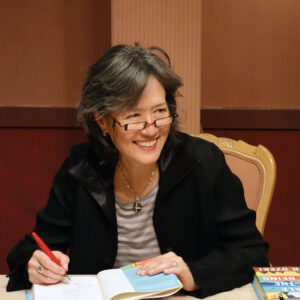
Just like her last name, Ruth Ozeki is a champion in storytelling that merges the subtleties of the east and the boldness of the west. Reading her works allows me to experience the best of both worlds. Just like her mixed race, her works are a fusion of the literary elements from both hemispheres.
One thing that I love about Japanese literature is its identifiable tone – slow-moving and languid. Just like when you are cooking miso soup, the miso is simply flowering and not bubbling. JLit is also cinematic and expertly uses nature and seasons to add to the story and major changes happen to the characters internally even though they are sitting at the bottom of the well for days or just go through their everyday life. In comparison, most American novels have a fast-paced narrative, too much external action and the characters are in constant motion.
Ruth Ozeki debuted with My Year of Meats, a book that will convince you to go vegan. After reading it, I cut down on beef, pork and chicken. Ozeki also showed the differences between a Japanese woman in a patriarchal society and half-Japanese growing up in the States – their beliefs, culture, and language.

After putting us off from meats, her next work, All Over Creation, planted a seed of suspicion on produce. Ozeki showed the “seedy” underbelly of agriculture, more specifically agribusiness, tapping on genetically-modified crops and excessive use of chemicals. The book also sends a message that we are all seeds in this never-ending cycle of beginnings and endings. Her exploration on what we eat stops here.
Her latest work, The Face: A Time Code, is a unique book. Ruth Ozeki conducted an observation experiment with her face inspired by Jennifer Roberts assignment to her students. Observing her features brings up memories and stories of Ruth’s life, so the book is part memoir. Upon reading The Face: A Time Code, readers will know that most of her novels were inspired by snippets of her life.
When was the last time you look at your face without judgment or regret? We make a fuss over every pimple and line. We stretch the skin in an attempt to turn back time while lamenting why we did not apply sunscreen and eye cream when we were a bit younger. I hope that when we look at your face, you will realise that the years are on your side and like a fine wine, you age with grace.
A Tale for the Time Being is one of the best books I have read and I highly recommend this novel. The book deals with life and death, but more importantly, it is about capturing NOW. Do you make every moment of your six billion moments daily count?
I love the flow of the interchanging story of Nao and Ruth and how they were tied at the end through a dream sequence, which Ozeki explained through quantum theory and parallel worlds. Some surreal writers like Haruki Murakami will not even bother to explain how a character ended up in a pit in his backyard, but I appreciate that she did not want to alienate overthinkers like me.
Ozeki used Buddhism (being a Buddhist priestess) and Japanese mythology drawing inspiration from her experiences and roots. I like how she uses a jungle crow or a yatagarasu, and only those who are familiar to Japanese mythology will get its meaning and will know how fitting its role is to the story.
Her works continue to get better every time and it amazes me how her books are different from each other. I cannot wait for the release of her latest book, The Book of Form and Emptiness, later this month.
[…] (蛇にピアス, Hebi ni Piasu) by Hitomi Kanehara for the second time. I recently read all of Ruth Ozeki’s works and A Tale for the Time Being made a huge impact on me. Thus, I was looking for a bit of transition […]